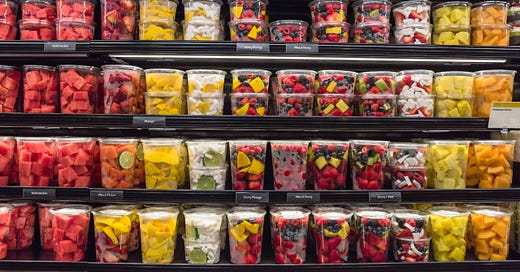10 Ways to Avoid Microplastics (And Not Go Crazy)
High-impact, low-effort ways to reduce your exposure to the next big health risk.
Post summary
On Monday, we covered possible health risks of microplastics, which are everywhere.
But you can still reduce your exposure.
You’ll learn the 10 highest-impact, low-effort ways to reduce the amount of microplastics you and your family take into your bodies.
Housekeeping
Full access to this post is for Members of Two Percent.
Membership gets you full access to Wednesday and Friday posts and all audio/podcast versions of our posts. Have fun, don’t die, become a Member.
Did you catch the new Two Percent dad/mom hats? They’re perfect for workouts, yard work, wrangling kids, and staging violent coups against the HOA.
Thanks to our partners, who make the best products in their categories.
Maui Nui Venison: Provider of the world’s healthiest meat (the research, linked here, is wild). My go-to: Organ blend 90-10 and pepper venison jerky sticks.
GORUCK: Maker of the best rucking gear (not stuff). Check out the Rucker 4.0.
Momentous Nutrition: The company that made me feel good about supplements again. My picks: Essential Plant Protein + Multivitamin.
Discount code EASTER for all brands.
Audio/podcast version
The post
On Monday, we explained what you need to know about microplastics. These tiny plastic particles are like air: All around us and within us. And they’re seemingly no good.
Growing and troubling research suggests they’re linked to health issues like heart and brain disease and much more.
We ingest them every day, and it’s impossible to totally avoid microplastics.
But here’s some good news: There are simple ways to lessen the amount of microplastics you and your family take in. These practices actually matter.
Perhaps even better news is that we don’t have to upend our lives and live like some back-to-the-land Earthers to lessen our exposure.
Two Percent is all about finding the highest-return practices that improve our health yet don’t make us slaves to our health routine. That’s what this post is all about.
We’re featuring 10 high-impact, low-effort ways to reduce your exposure to microplastics, the next big health threat. Let’s roll …
1. Avoid bottled water and other drinks
One study found: “Individuals who meet their recommended water intake through only bottled sources may be ingesting an additional 90000 microplastics annually, compared to 4000 microplastics for those who consume only tap water.”
This is because your standard 500ml water bottle contains about 125,000 particles of nanoplastics (microplastics that are smaller than 1000 nanometers in size), according to one study.
A bottle of water, Gatorade, or diet soda here and there is probably fine. But you probably don’t want to be drinking them all day.
2. Maybe drink from cans less often too
Researchers at UCLA wanted to understand how soda packaging impacts the microplastics in the drink.
So they analyzed soda in plastic bottles, aluminum cans, and glass bottles from four different cities in the United States: Los Angeles, Chicago, Atlanta, and Washington D.C.
You’d think the plastic bottles would contain the most microplastics.
But the scientists actually found, “no distinguishability was revealed between the different container types … This indicates that plastic bottles did not significantly contribute to an increase in microplastics levels during the intended usage period.”
One independent test, for example, found that a can of Brisk Iced Tea had the highest levels of microplastics, beating a plastic bottle of Coca Cola and Poland Spring water.
The factor that most led to a drink’s microplastics load was surprising. Which leads us to our next important point …




